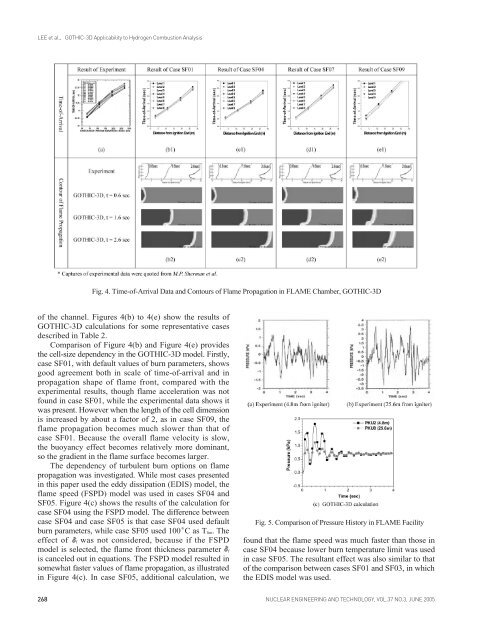GOTHIC-3D APPLICABILITY TO HYDROGEN COMBUSTION ANALYSIS
Create successful ePaper yourself
Turn your PDF publications into a flip-book with our unique Google optimized e-Paper software.
LEE et al., <strong>GOTHIC</strong>-<strong>3D</strong> Applicability to Hydrogen Combustion Analysis<br />
Fig. 4. Time-of-Arrival Data and Contours of Flame Propagation in FLAME Chamber, <strong>GOTHIC</strong>-<strong>3D</strong><br />
of the channel. Figures 4(b) to 4(e) show the results of<br />
<strong>GOTHIC</strong>-<strong>3D</strong> calculations for some representative cases<br />
described in Table 2.<br />
Comparison of Figure 4(b) and Figure 4(e) provides<br />
the cell-size dependency in the <strong>GOTHIC</strong>-<strong>3D</strong> model. Firstly,<br />
case SF01, with default values of burn parameters, shows<br />
good agreement both in scale of time-of-arrival and in<br />
propagation shape of flame front, compared with the<br />
experimental results, though flame acceleration was not<br />
found in case SF01, while the experimental data shows it<br />
was present. However when the length of the cell dimension<br />
is increased by about a factor of 2, as in case SF09, the<br />
flame propagation becomes much slower than that of<br />
case SF01. Because the overall flame velocity is slow,<br />
the buoyancy effect becomes relatively more dominant,<br />
so the gradient in the flame surface becomes larger.<br />
The dependency of turbulent burn options on flame<br />
propagation was investigated. While most cases presented<br />
in this paper used the eddy dissipation (EDIS) model, the<br />
flame speed (FSPD) model was used in cases SF04 and<br />
SF05. Figure 4(c) shows the results of the calculation for<br />
case SF04 using the FSPD model. The difference between<br />
case SF04 and case SF05 is that case SF04 used default<br />
burn parameters, while case SF05 used 100 C as T lim. The<br />
effect of f was not considered, because if the FSPD<br />
model is selected, the flame front thickness parameter f<br />
is canceled out in equations. The FSPD model resulted in<br />
somewhat faster values of flame propagation, as illustrated<br />
in Figure 4(c). In case SF05, additional calculation, we<br />
Fig. 5. Comparison of Pressure History in FLAME Facility<br />
found that the flame speed was much faster than those in<br />
case SF04 because lower burn temperature limit was used<br />
in case SF05. The resultant effect was also similar to that<br />
of the comparison between cases SF01 and SF03, in which<br />
the EDIS model was used.<br />
268 NUCLEAR ENGINEERING AND TECHNOLOGY, VOL.37 NO.3, JUNE 2005



